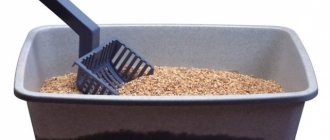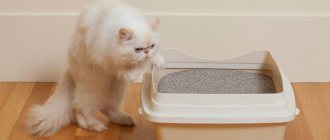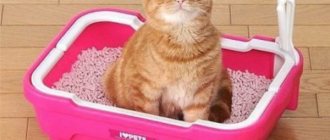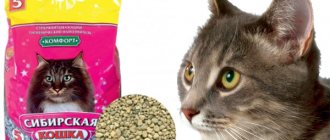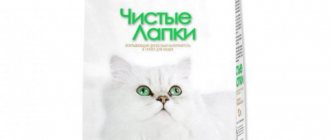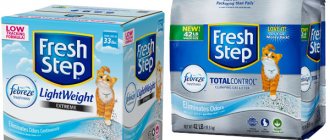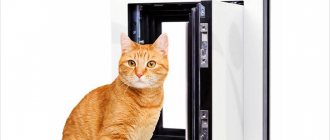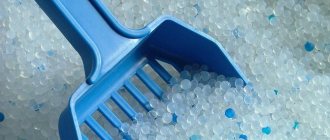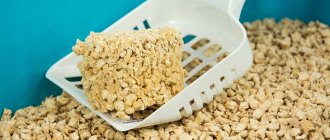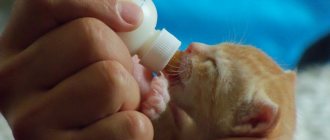Sphynx cats need increased attention and care, this also applies to the toilet. Before getting a Don or Canadian Sphynx, it is recommended to study information on forums, from breeders, and other cat owners. Since they differ in some features in litter box training, you need to prepare for the possible difficulties of this process. Experienced owners of sphinxes advise potty training the animal from a young age, this will make it easier for him to develop the necessary habit.
comparison table
For the purpose of visual comparison of the presented funds, we use the comparison table below.
| Filler | Volume (l) | Compound | Antibacterial effect | Price, rub.) |
| Ever Clean | 10 | clay | Yes | from 1100 to 2527 |
| Barsik Standard | 4,5 | clay | Yes | from 78 to 326 |
| Zoonic | 5 | clay | Yes | from 120 to 672 |
| Pi-pi-bent | 10 | clay | Yes | from 256 to 931 |
| Fresh Step Extreme Clay | 12 | clay | Yes | from 904 to 2169 |
What kind of litter should a kitten have?
The requirements for the appearance and composition of litter for kittens and adult cats are largely the same:
- he should not scratch the pads on his paws,
- be light enough so that the kitten can easily dig up and bury all his “business”,
- safe for the digestive system - when little kittens first get acquainted with the contents of the tray, they will definitely try it on their teeth, while not all varieties are completely safe for the stomach,
- dust-free, so as not to cause irritation of the mucous membranes of the nasopharynx and eye diseases,
- the granules should not rustle too much, so as not to frighten the kitten, who is just getting used to the tray. This will not affect your health in any way, but it may cause unpleasant associations with the toilet, which will complicate addiction,
- the filler should not completely suppress the smell, since at first it will be the main reference point for the new resident of your apartment, however, you yourself may not even smell it, since the sense of smell in cats is several times more developed.
How to use it correctly?
There are a number of rules for using clumping litter that must be followed:
- First, wash and dry the tray thoroughly.
- Spread the filler in a thick layer of 3-5 cm. It is easy to remove lumps and animal waste products from such a layer. Exact recommendations are usually indicated on the packaging.
- After the animal relieves itself, the filler absorbs moisture and lumps form.
- You need to throw out the lumps every day with a special scoop.
- After cleaning, the filler should be added to the required level and leveled with a spatula.
- The tray should be completely changed approximately once every 1-2 weeks.
Remember, clumping fillers cannot be disposed of down the drain, otherwise the clay mass will harden and clog the pipe. Lumps should be placed in bags and thrown into the trash.
Possible difficulties
There are several reasons why a Sphynx may refuse to defecate in a litter tray. The first of them is that the cat simply does not like her toilet. It may not fit the size of the animal, making it difficult for him to concentrate in it. The main factor is considered to be a poorly washed pot. New smells and aromas can scare away a cat, or they may not like the litter. The Sphinx is a vindictive creature; if you raise your voice or raise your hand, it can become offended and specifically refuse to go to the litter box. This way he will mark his territory throughout the house and leave wet footprints in the most unpredictable places. If there are health problems, if there are problems with urination, the Sphynx may simply not have time to get to her own toilet and defecate wherever she has to. In this case, it is recommended to seek help from a veterinarian.
What to look for when choosing
To choose a product that would satisfy both your pet and you, you should consider the type of filler.
- Clay. The advantages include its natural composition. The product is also suitable for cats of any age and is best accepted by them. Reminds me of regular soil. However, sometimes the product becomes dusty and sticks to the fur. It is worth considering that this filler cannot be disposed of in the sewer. Pipes may become clogged. Dust remains at the bottom of the package. Care must be taken.
- Silica gel. This type absorbs moisture best and copes well with unwanted odors. This filler should be changed once a week. The granules do not stick to the animal's paws and fur. There is no dust. But often the composition contains acids, so it is not advisable to buy such a product if you have a kitten.
- Woody. The most environmentally friendly type of filler. It can be flushed down the drain. The product has a natural aroma and is suitable for animals of any age. The disadvantages include frequent cleaning of the tray. In addition, the product sticks to the paws.
- Corn. This product can be flushed down the toilet and even used as fertilizer. The product absorbs moisture and odors well. However, there is a chance that the pet will scatter the granules outside the tray, because they are quite light in weight.
- Paper. This type is produced by processing paper raw materials. The advantages include rapid absorption of liquid and moisture. The granules will not stick to the paws. But such a product requires frequent replacement, and rustling noise is also heard when the cat is in the tray.
- Carbonic. Effectively absorbs all odors. Has antimicrobial effects. It absorbs moisture from the air, so it is not recommended to place a tray with this filler in bathrooms.
Stages of training
In order for the baby to quickly remember the latrine, he needs to be dropped off there after eating.
It is recommended to feed the Sphinx and carefully place it on the pot. One of the instincts of these animals is to bury their own feces. You need to wait a little until the pet gets used to it, sniffs the tray and then he can instinctively start digging in it. If the cat does not understand what to do, you need to take him by the front paw and show him the movement. After the first time, when it comes off in a small way, the smell of urine will remain on the filler, which will let the sphinx know that it needs to come back here again.
You cannot scold an animal if it fails to go potty on the first try. You need to bring the cat to the litter box over and over again and repeat the training procedure. If your bald pet continues to defecate in other places, you can take newspaper or paper, tear it into small pieces and soak it in urine. Next, take it to the cat's litter box and leave it on top of the litter.
You shouldn’t poke the sphinx’s nose into a puddle in the wrong place, hit it and scream. Otherwise, the animal may continue to “go about its business” throughout the house in retaliation.
If the owner’s attempts are not successful, then the animal should be shown to a doctor.
If you repeat the entire process without deviating from the goal, the cat will understand that it only needs to defecate in the tray. It doesn't take long to train a kitten, but there are exceptions. By the way, the Sphynx breed can be planted on a tray without filler. For many cats, this is the only option suitable. If your pet does not learn to go potty within 2-3 weeks, it is recommended to show him to a veterinarian to exclude the possibility of developing diseases of the genitourinary system.
The Best Clay Cat Litters
This type of filler is inexpensive and can be used in the tray for a long time without replacement, but it retains the odor a little worse than wood filler.
See also: Rating of the best alarm systems with and without auto start 2018-2019
Catsan Ultra Plus 5 l
This cat litter is highly rated for its ability to keep your home clean. When wet, the raw materials do not stick to the cats' paws and do not spread across the floor. In case of ingestion of particles, nothing threatens the pet’s health, since the material is natural and does not cause intoxication. Wet lumps can be easily removed with a spatula; there is no need to completely replace the contents of the tray. The composition of Catsan Ultra Plus is close to the most natural, so four-legged animals stop walking past the toilet.
Advantages
- Small granule size;
- Softness of raw materials;
- When combined with water, they form compact pieces, which makes cleaning in the tray easier;
- Natural composition;
- Does not cause allergies.
Flaws
- Small volume.
The bag in which the Catsan Ultra Plus filler is packed is made of thick paper and equipped with a convenient handle for comfortable carrying.
SELECTING FILLER AND TRAY FOR SPHINX
Everyone has once walked into an apartment where the smell of cat litter comes from the door. As a rule, only one desire arises there - to quickly get out of such a room! The torn newspapers in the cat tray are long gone. On the shelves of stores, and not just pet stores, there is simply a huge assortment of different litters for pet litter. And there are no less trays on sale either. But how to make a choice? How to decide: what is suitable for the Canadian Sphynx and what is not. After all, the comfort in the whole house depends on the toilet filler. And it depends on the shape and type of the tray whether you will persistently hide it from prying eyes. The Canadian Sphynx nursery "Canadavillage" has been trying for a long time to find the ideal litter that would be perfect in all respects: it does not generate dust, is economical, does not stick to the scoop and the bottom of the tray, and completely retains odors. Considering that there is far more than one breeding animal in the nursery, all the requirements for the filler are very relevant! Let us share our experience, figure it out together and divide all the fillers into certain categories, find out the advantages and disadvantages of each of them.
So, all fillers can be divided into three categories:
— sand or clay (opka, bentonite, zeolite) filler; — wood filler, corn, paper, sawdust; - silica gel filler.
Let's take a closer look at each of the categories of fillers.
Sand or clay litter for cats: Can be of different sizes: - small - it is quite economical, but at the same time it contains a sufficient amount of dust, and if the Sphynx likes to rummage intensively, then not only the pet, but the whole house will be covered in dust; - medium is considered optimal, it contains almost no dust and is relatively economical; - coarse is more like fine gravel, there is no dust in it. Its main disadvantage is that it is uneconomical; due to its large size, this filler is consumed quite quickly and is considered the most unprofitable among this group of fillers.
Sand or clay can be clumping or absorbent. Clumping litter means that the part that contains cat feces will form a small clump that can be thrown away. In this case, the main part of the filler does not need to be replaced. If there were a lot of lumps, then you can add a little fresh filler and completely replace it every few days. The absorbent filler acts somewhat differently; it absorbs moisture and the sphinx can go into the tray several times without changing the filler. Of course, there are several disadvantages here - if the filler is of poor quality, then the smell from the tray will appear very quickly and it cannot be left for the whole day. In addition, Sphynx cats are too clean and they do not want to go into a litter box that smells bad. The absorbent filler must be chosen carefully; it must perfectly absorb not only moisture, but also odor, otherwise the owner will be forced to constantly change it in the tray.
This type of filler has many disadvantages: the smell is not completely absorbed, many brands of filler contain dust, and it needs to be changed frequently.
Opinion of specialists from the Canadian Sphynx nursery “Canadavillage”: The new generation of hygienic litters is made on the basis of sodium bentonite clay and, due to the structure of its granules, has the unique ability to instantly form a dense lump. The formation of a dense lump allows you to use the filler more economically and keep the tray clean. Fillers with an improved formula absorb and clump even faster, preventing urine from leaking to the bottom of the tray, neutralize odors, are more economical and do not generate dust!
In some brands of filler, activated charcoal and an antibacterial component are additionally added to the filler granules, which destroys bacteria that produce ammonia.
The Canadian Sphynx nursery "Canadavillage" chose Ever Clean brand litter - this is an elite series of high-quality clumping litters with unique properties. Since Ever Clean is made from bentonite, a clay with unique absorbent properties, one package will last your kitten for up to 2 months. In the opinion of the nursery workers, this filler is simply great for kittens. Low content of dust, allergens, absence of harmful substances and foreign odors, plus small granule size - very convenient for the delicate paws of a Sphynx kitten.
The main cause of the unpleasant “cat” odor is bacteria that produce ammonia when exposed to air. Consequently, the faster the filler stops interaction with air, the less unpleasant odor there will be in the room. There is a series of this brand of litter (Ever Clean) for several animals in the house, which is especially important in nurseries.
Hypoallergenic Ever Clean consists of 99% specially processed, purified and dust-free clay, so there are no allergic reactions to this filler in people and sphinxes. Special substances in Ever Clean destroy bacteria and absorb unpleasant odors, and some types of Ever Clean release aroma when liquid enters it. One of the latest innovations in the filler category is patented technology using activated carbon. To the traditional antibacterial component in the granule shell, which prevents bacteria from multiplying, a new development has been added - an “odor trap” - this is a specially treated activated carbon in the granule core. Activated carbon capsules capture and hold unpleasant odors inside.
Wood (paper) cat litter
This filler consists of large granules of pressed sawdust or paper. Wood filler is considered the safest and most natural. Wooden pellets get wet when exposed to moisture and absorb odor very well. Owners do not need to change the entire filler - just throw away the part where the granules have swollen and turned into sawdust. Advantages: - low price - absence of dust and small granules; - considered the most economical to use - granules absorb well and retain the smell for a long time; - easy to recycle; — granules are made from natural raw materials and do not cause allergies in animals and owners.
Flaws:
— granules that are too large are not suitable for kittens; — an adult Sphynx may refuse such a filler, since she has never used pressed granules before (it is better to make the transition to such a filler gradually); — swollen sawdust can get caught on the cat’s paws.
Opinion of specialists from the Canadian Sphynx nursery “Canadavillage”: The granules are too rough for the delicate paws of kittens. Sphynx cubs simply do not want to go into such a filler. And considering that the breeding mothers of the nursery have also never used pellets of this size, they cannot train their children to go into a tray with such filler. The nursery animals, protesting against the wood filler, did all their business not in the tray, but next to the tray. The nursery categorically refused to use this type of litter.
Silica gel cat litter
This new generation of filler looks rather unusual - its structure resembles sea salt. It works similar to absorbent sand, but the formula works much better and is really worth considering. The silica gel filler is poured into the tray at least 3 cm deep - this is necessary so that the granules can absorb all the moisture that gets into them. Moisture penetrates into the granules and their structure remains virtually unchanged. Only after a few days, when a significant amount of moisture has collected in the tray, the granules will change shape and become gel-like. It will be quite dense, and throwing it away will not be difficult. This filler is considered the best - it absorbs moisture and odor 100%. In addition, it does not need to be changed often - one filling of the tray is enough for 7-10 days.
Advantages: — convenient to use; - no need to clean the tray often; — no dust; — absorbs moisture and odor; - non-toxic, does not cause allergies.
Disadvantages: - high price.
In principle, this filler has no disadvantages, except for the price, but if you compare it with the price of other fillers, it turns out that silica gel granules are even more profitable.
Opinion of specialists from the Canadian Sphynx nursery “Canadavillage”: The silica gel filler granules are also large enough for the delicate paws of Sphynxes. Sphynxes are quite reluctant to accept this type of litter. Odor retention was not a feature of silica gel fillers. The granules clump immediately, changing their color and turning into a lump. With a large number of Sphynxes, the nursery workers did not have the patience to wait 7-10 days for the granules to turn into a gel. The difference between clay and silica gel filler in favor of silica gel was not noticed by the nursery workers.
After testing various types and brands of fillers, the choice was clear - Ever Clean bentonite filler! If this brand of filler is not available in pet stores, you can order it in an online store or use more affordable brands of filler such as “Clean Paws”, “Happy Paws”, “Pee-Pee-Bent”.
If you don’t know whether it’s worth changing the litter to a new one and how your pet will react to this, take a small package of the new litter and gradually mix it with the old litter. This way you will give the Sphynx time to get used to it and you will understand for yourself whether the new filler is suitable for both you and your pet.
It is enough for a small Sphynx kitten to show where its tray is. You can drop your baby there several times after eating, playing and sleeping. This will be enough for the kitten to remember in the new home where his toilet is. Older, older kittens will most likely figure out on their own where their litter tray is located. There can be only a few reasons for sphinxes walking past the litter tray: health (excluding the other reasons listed below, we recommend that you immediately check with a veterinarian for urolithiasis); tags; conflicts between animals; unsuitable filler for the Sphynx.
There are several secrets for correctly installing the tray. Often, new owners save on the filler, hide the tray in the most inaccessible places so that it is not visible, or place the tray in the aisle, by the front door, or, conversely, next to bowls of food.
It turns out that the use of filler becomes twice as economical if it is poured 5-7 cm, rather than covering only the bottom of the tray. In order not to hide the tray in secluded places, we suggest buying a tray-house right away. As a rule, such trays are already equipped with both a carbon filter and a scoop. There will also be significantly less filler on the floor when using a house tray. We remind you that all kittens from the Canadian Sphynx nursery “Canadavillage” are fully litter box trained by the time they move to a new home. And the baby would rather endure a day if he doesn’t understand where his toilet is, rather than pee anywhere in the new house! However, at first we recommend placing the kitten’s litter box in the same room as him, so that the baby does not have to go outside the territory that you have allocated for him to adapt for the first time and look for his new toilet throughout the apartment or house. Once the kitten gets used to the new home and has completely mastered it, the tray can be placed where you think it needs to be.
Types of mixtures
Cat litter is made in the form of balls, which can be small, medium and large. They all resemble the natural environment that a cat prefers. Granules are made from different materials that absorb liquid and even odors well. Some fillers need to be changed completely, while from others only used balls or lumps are selected.
© shutterstock
Bedding is divided into two main types - absorbent and clumping. They eliminate fluids in different ways. The types of cat litter also differ in the materials used for the production of granules :
- mineral based;
- corn;
- from sawdust of trees;
- clay-based;
- in the form of silica gel balls.
All fillers are collected differently. Clumping - into piles, absorbent - simply crumbles and does not need daily replacement.
Choosing clumping litter
Choosing cat litter is not as easy a task as it seems. A large number of domestic and foreign companies engaged in the production and distribution of clumping sorbents have filled the market with a variety of products.
Therefore, it is recommended to look at products from well-known companies that guarantee high quality and environmental friendliness. You need to be careful when choosing fillers with various aromatic additives. An unusual smell can scare your pet away from the litter box. Cat Step clumping cat litters are considered the best. They are made on the basis of bentonite, are hypoallergenic, have antibacterial properties, provide excellent odor protection, and are packaged in 5 and 6 kg packs. Well suited for litter box training for small kittens. If the animal likes to dig, then the filler will always be scattered near the tray. In this case, it is better to purchase a toilet in the form of a house or place the tray on an artificial grass mat so that the filler particles are retained in the pile.
Clumping filler "Zoonik"
is one of the largest manufacturers of pet accessories and cat litter. In 2000, the trademark “Zoonik” was registered, under which more than 1000 types of high-quality products are produced. One of which is “Zoonik” clumping cat litter. Using advanced technologies and the best European experience, the company produces high-quality and competitive Zoonic fillers. The basis is an environmentally friendly mineral product - bentonite clay. The filler does not generate dust or crumble when used, so the animal’s paws remain clean, as does the floor around the tray. Possessing high hygroscopicity, the filler absorbs odor well. Lumps that form when moisture is absorbed can be easily removed with a special scoop. The filler is economical, it does not need to be replaced daily, you just need to add it to the required volume. The price is quite reasonable.
Clumping fillers "Kat"
Consider the following clumping cat litter “Kat”:
- “Pussy-Kat” is produced in Russia using all the latest developments and sanitary standards. Created on the basis of bentonite clay and the natural mineral zeolite. It does not stick to the fur and paws of the animal, does not spread around the apartment, is easy to care for and is hygienic.
- “Sea Sea Cat” is a Russian filler in Bryansk. It is made from natural raw materials – blue clay, which is used for medicinal purposes. The product is environmentally friendly, clumps well, does not produce an unpleasant odor, and is easy to use.
- "Pretty Kat" is made from the best mixtures of bentonite clays. It clumps well into perfectly even balls, perfectly absorbs liquid, eliminates odors, and does not generate dust. The filler is antibacterial, and the small size of the granules is suitable for the delicate paws of kittens.
All litters are easy to use, and to make sure they suit your cat, you need to try which one she likes best.
Rating of the best cat litters
When compiling this TOP and in selecting good cat litter, customer reviews and veterinarian opinions played a huge role.
These are the parameters we also paid attention to when analyzing the characteristics of the product:
- Type – wood, silica gel, corn, mineral or clay;
- Packaging volume and its convenience;
- Natural composition and safety of use;
- Reaction of cats to raw materials;
- Type – absorbent or clumping;
- Ease of use – can it be flushed down the toilet, is it easy to clean with a spatula, etc.;
- Natural aroma and protection against urine odor;
- Which cats are suitable for – by age and breed;
- Economical consumption and replacement frequency.
A special selection criterion was the price-quality ratio of the fillers, the brand under which they are produced, and their availability for sale.
The best cat carriers according to customer reviews
